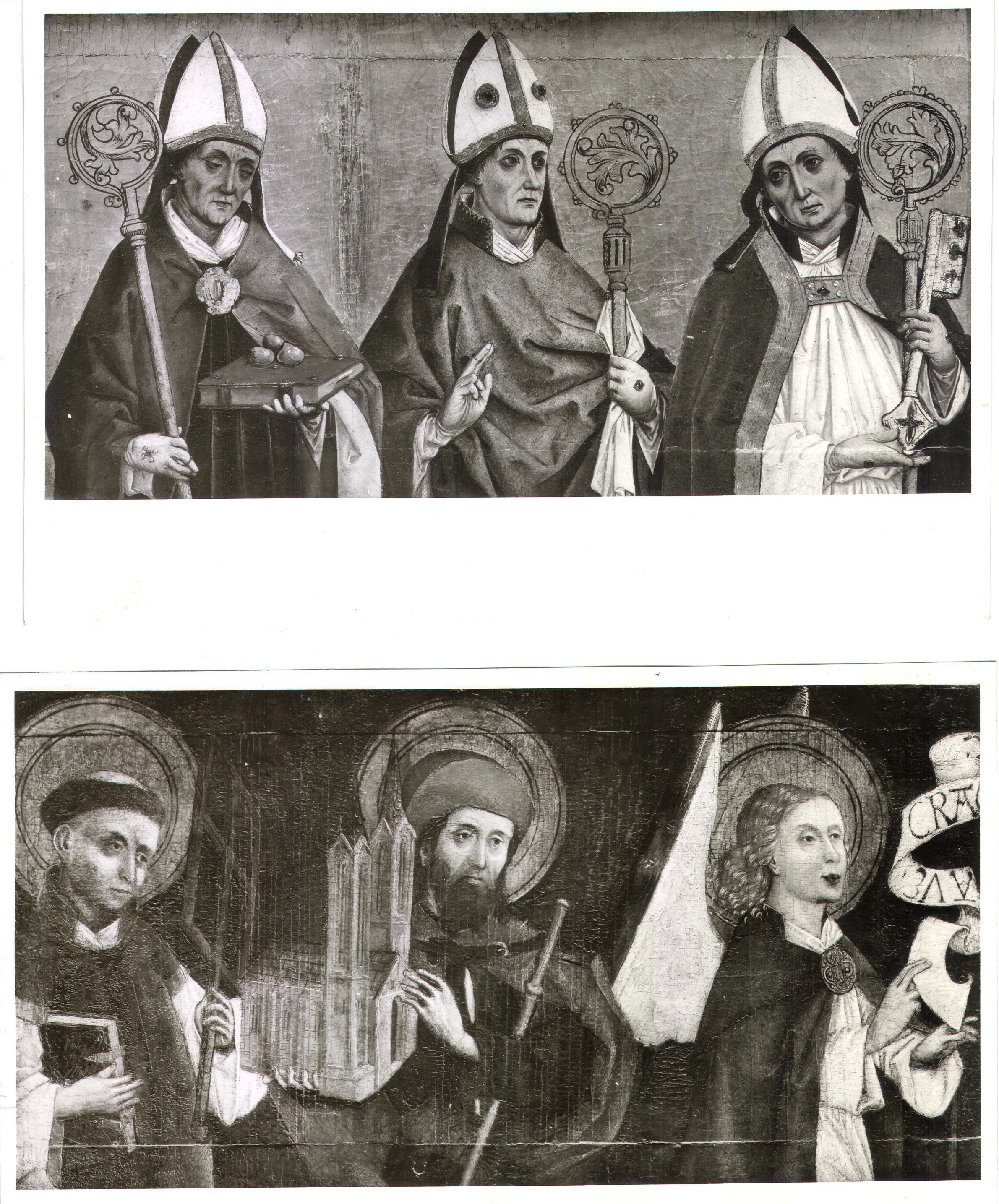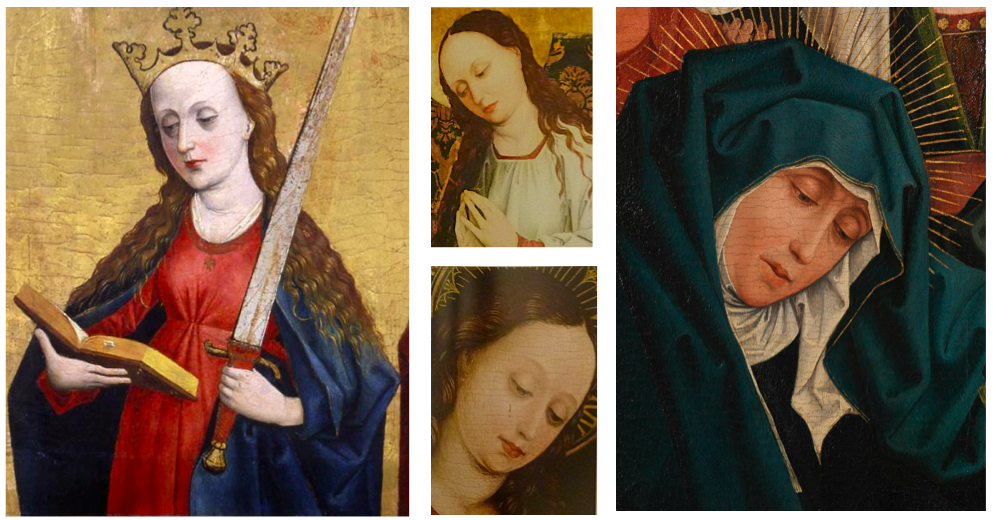
Late-gothic panels in York Art Gallery – part 1.

Another article presenting results of my research in the National Inventory of Continental European Paintings project has just been published – therefore I decided to present some of these results also here on my blog. This time it is about a late gothic panel, painted on both sides, described in the York Art Gallery catalogue only as “2nd half of the 15th century, Nuremberg School”. I have so much to tell you about this artwork that I have decided to split it into two posts.
Originally there used to be two panels in York Art Gallery, both of the same size and in the identical frames, painted on both sides and both obviously created by the same pair of artists. They contain the depictions of three saints in half-length on each side. One side of each panel has a golden background, suggesting it used to be in the inner side of the altar-wings, while in the other side the saints are placed against the dark background (outer side of the altar-wings). One artist decorated golden-background sides of both panels, and the other painted saints on dark-background sides. Unfortunately, one of those panels was stolen from the Gallery on 13th November 1979 and its current location remains unknown. All we have is black-and-white photograph.
I remember how exciting it was for me to examine the panel that is still present in York Art Gallery. Not only because I got to touch a late-medieval painting (using gloves, of course!), but also because I enjoyed finding something Central-European in the museum in York. It seemed that this artwork had not been properly researched earlier; there was almost no information about it collected in the museum’s archives. Basically, there was only a general summary prepared for the note in the York Art Gallery catalogue, published in 1961 (prior to the theft of one of the panels). It read that the panels date back to the 2nd half of the 15th century, that they most likely come from Nuremberg, and that they contain depictions of certain Saints (with some errors in identification, but that is a different story). Also, the provenance of the panels was summed-up: they first appeared at Louis Breitmeyer’s sale at Christie’s, Manson & Woods in London on 27th June 1930, and were later sold at an anonymous sale at the same auction house on 15th July 1955. In 1956 the panels were with the Arcade Gallery in London, from where they were purchased by Francis Dennis Lycett Green. He was the most important benefactor of Art Gallery in York, giving his entire collection of 130 pictures to the Gallery in 1955. In 1957 he also given the Art Gallery in York two above-mentioned panels.
The one that has been stolen contained three half-figure depictions of Saints Bishops on the recto side (against the golden background). One of them was St Nicolas, holding a book with three pieces of gold (I wrote about this attribute HERE), and another, who was holding a key, should be identified as St Servatius (a bishop of Tongeren living in the 4th century) – his attribute is a key, as according to the legend St Peter handed the Keys to the Heaven to him. The third bishop with no particular attribute may be – perhaps? – St Augustine. The verso side of that panel contained the depictions of St Lawrence (holding a gridiron – I wrote about this attribute HERE) and St Sebald, the patron Saints of Nuremberg; the latter depicted in as a pilgrim holding a model of his church. By the right edge the Archangel Gabriel was holding a banner with his greeting (AVE GRA[tia]) – undoubtedly there must have been another panel with the depiction of the Virgin, completing the scene of Annunciation.
The panel still present in York Art Gallery is decorated with some depictions of Dominican Saints. Against the golden background we may see St Dominic, accompanied by early-Christian virgin martyrs: Catherine of Alexandria and Barbara. On the other side there is St Catherine of Siena (dressed as a tertiary of the Dominican Order, holding crucifix embedded in a heart) and St Thomas Aquinas, with white Dove of the Holy Spirit by his ear. There is also St Ursula, holding an arrow.
When I saw this picture for the first time, I immediately thought it looked familiar – I have seen similar figures, especially stylistically close to the ones here painted against the golden background. It didn’t take me a long time to spot the source of my association in the digitalised collection of the Germanisches Nationalmuseum in Nuremberg: the altar-wings of St Catherine of Siena altarpiece, completed in 1464 by the workshop of Hans Pleydenwurff to the church of the Dominican Nuns’ Convent in Nuremberg. In fact, there are many other artworks attributed to the Pleydenwurff’s workshop, which was one of the most important ones in Nuremberg in the third quarter of the fifteenth century. Hans Pleydenwurff moved to Nuremberg in 1457 and died in 1472; his workshop was taken over by Michael Wolgemuth, who married Pleydenwurff’s widow, and later was a teacher of famous Albrecht Dürer.
Clothes, hands, and most of all faces of men depicted in York panels seem to have been painted by the same artist who created saints in the wings of the St Catherine of Siena altarpiece:
Also, female Saints in the York panels look very similar to women depicted in other artworks by Hans Pleydenwurff or his workshop (e.g. from the Hof Altarpiece, from the Altar of the Three Kings from the St Lawrence church in Nuremberg, or from Epitaph of Count Georg von Löwenstein):
Attributing York panels to the workshop of Hans Pleydenwurff is a big deal; alas, I have not enjoyed the satisfaction of the discovery for a long time. As soon as I checked on the German literature on Nuremberg St Catherine of Siena altarpiece, I found out that German scholars connected York panels with this altarpiece already in the 1970s! In his last comprehensive monograph of the Nuremberg painting before Dürer, prof. Robert Suckale described the York panels as the wings of predella of St Catherine of Siena Altarpiece (R. Suckale, “Die Erneuerung der Malkunst vor Dürer”, Petersberg 2009). Interestingly, he only attached black-and-white photographs of the York panels, and described them as of an unknown location (last seen in Arcade Gallery in 1956)! That information is actually repeated in all the earlier German references.
So, to sum up: museum in York housed late-gothic panels for over 60 years, not aware of the fact that German scholars attributed them to the workshop of Hans Pleydenwurff and connected with a particular altarpiece. On the other hand, German scholars considered the panels in question as of an unknown location, using only old black-and-white photos, while the artworks have been all the time available in British public collection! That is why all the museums should have their collections digitalised. Of course, I have written to Germanisches Nationalmuseum and they have corrected information on York panels both on their website as in the new catalogue, published in 2019:
The curators from Nuremberg still assume that York panels used to be predella-wings (German Predellenflügel) of the St Catherine of Siena Altarpiece, wings of which are now in the Germanisches Nationalmuseum. I do not agree with that – but this is another part of the story, to be told in the upcoming post on my blog.
***
My article Late Gothic Panels from the Collection of York Art Gallery: Predella-Wings from the Workshop of Hans Pleydenwurff, in: Biuletyn Historii Sztuki 2/2019, pp. 177-196 is available on-line.
Second post on the subject is available here: http://en.posztukiwania.pl/2020/05/02/late-gothic-panels-in-york-art-gallery-part-2/
UPDATE 2023:
The stolen panel has just been found! http://en.posztukiwania.pl/2023/07/09/a-stolen-painting-returned-to-york-art-gallery/














Hello,
in my collection I found a painting with similar female faces.
After I passed it to the German National Museum I got the answer to research
for Pleydenwurff or workshop. You have a knowledge about this painter? Regards Paul Pfisterer
Hello!
How interesting!
My article referred to at the end of this post (in English, available online: https://czasopisma.ispan.pl/index.php/bhs/article/view/315/215) refers to the artist and gives further reading in footnotes (paragraph starting on page 184: “Hans Pleydenwurff came from a Bamberg family; he moved to Nuremberg in 1457”). But it is a very brief summary, as Hans Pleydenwurff was one of the most important Central European late gothic artists, and ran a busy workshop in Nuremberg. I very much recommend you recently published GNM catalogue: Daniel HESS, Dagmar HIRSCHFELDER, Katja von BAUM (Eds.): Die Gemälde des Spätmittelalters im Germanischen Nationalmuseum, vol. I: Franken, Regensburg 2019.
Also, please feel free to write to me directly about the paintings in your collection: magdalena_lanuszka@o2.pl
🙂